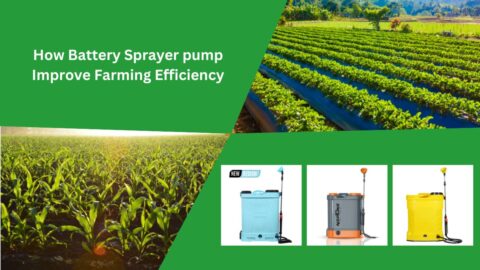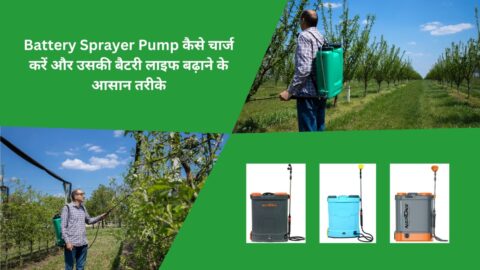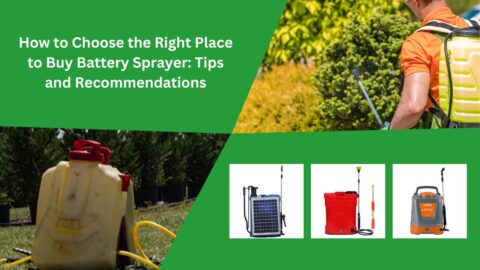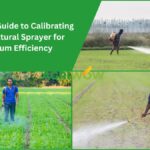A battery sprayer for agriculture is a modern farming essential that makes spraying fertilizers, pesticides, and herbicides faster, easier, and more efficient. It saves both time and effort while ensuring uniform application across your field or garden. However, when your sprayer suddenly stops working, it can bring your operations to a halt. Don’t worry, most issues are easy to fix once you know what to look for.
Here are 7 common reasons why your battery sprayer might not be working and how to fix them, often in less than a minute!
1. Low or Depleted Battery
A low or dead battery is the most common reason your sprayer won’t start. The pump motor requires enough voltage to run, and without it, it either won’t start or will run weakly.
How to Check: Look at the battery indicator (if your sprayer has one) or test it with a multimeter.
How to Fix: Recharge the battery completely. If the battery no longer holds a charge, it’s time for a replacement.
2. Clogged Nozzle
If your battery sprayer pump is running but little or no liquid is coming out, the nozzle might be blocked by dried chemicals or dirt.
How to Check: Inspect the nozzle opening for buildup or residue.
How to Fix: Remove the nozzle and clean it gently with a soft brush or pin. Never blow it with your mouth, as chemical residue may still be present.
3. Clogged Suction Filter or Strainer
Inside the tank or at the end of the suction hose, there’s usually a filter that prevents debris from entering the pump. When this filter gets clogged, the pump can’t draw liquid properly.
How to Check: Open the tank and inspect the suction filter or strainer.
How to Fix: Rinse it with clean water until all debris is cleared. This quick step can often fix your sprayer in under a minute!
4. Kinked or Pinched Hose
Sometimes the issue is as simple as a bent or pinched hose that blocks the liquid flow.
How to Check: Follow the hose from the tank to the wand and look for bends, folds, or trapped sections.
How to Fix: Straighten the hose and make sure it has a smooth, unobstructed path.
5. Loose Electrical Connection
Continuous use and vibration can loosen wires, especially around the battery or motor terminals.
How to Check: Inspect all visible wires and terminals carefully.
How to Fix: Tighten loose connections and clean any corrosion from the terminals. Always disconnect the battery before touching wires.
6. Faulty Pump Diaphragm or Motor
If the motor runs but doesn’t build pressure, the internal diaphragm could be worn or damaged. If the motor doesn’t run at all (even with full battery), it might be dead.
How to Check: Listen for the motor. If it’s running weakly or not at all, the pump assembly may need attention.
How to Fix: Replace the diaphragm using a pump repair kit. For a dead motor, you’ll need to replace the entire pump.
7. Air Leak in the Suction Line 🌬️
Air leaks prevent proper suction, leading to poor or no spraying.
How to Check: Look for bubbles near the suction line or listen for a hissing sound.
How to Fix: Tighten all hose and tank connections and ensure seals are secure.
Double Motor vs. Single Motor Battery Sprayer: Which is Right for Your Farm?
When choosing a neptune battery sprayer, you’ll find two main types — single-motor and double-motor units. Your choice depends on how much power and coverage you need.
| Feature | Single Motor Sprayer | Double Motor Sprayer |
| Pressure & Flow | Lower (40–70 PSI) | Higher (80–120+ PSI) |
| Battery Drain | Lower, longer run time | Higher, shorter run time |
| Best Use | Small to medium gardens, spot treatments | Large farms, orchards, tall trees |
| Cost | Lower initial cost | Higher initial cost |
Single Motor Sprayers are ideal for smaller areas and general farm use. They’re energy-efficient and affordable.
Double Motor Sprayers deliver higher pressure and volume — perfect for large farms or spraying tall crops. They help you cover large areas quickly and efficiently.
Verdict: For homeowners or small farmers, a single motor unit is cost-effective and sufficient. For commercial farmers or high-demand spraying, go for a double motor sprayer for maximum performance.
Pro Tip for Longevity
Always flush your sprayer with clean water after every use. This prevents chemical buildup that causes clogs and wear. A little maintenance ensures your sprayer is always ready for your next spraying session!
Keep your manual spray pump clean, check for issues regularly, and it’ll serve you well for years. Don’t let a small issue slow you down, learn the fix and keep spraying with confidence!
FAQs
Q1. How do I know if my battery sprayer motor is damaged?
If your sprayer is fully charged but the motor doesn’t start or makes a clicking sound, it may be due to a damaged diaphragm or motor. Check the wiring and test the motor directly with a battery. If it still doesn’t run, replacement is necessary.
Q2. Why is my battery sprayer not building pressure?
This usually happens due to air leaks, a clogged nozzle, or a damaged diaphragm. Make sure all hose connections are tight, clean the nozzle, and check the pump for cracks or wear.
Q3. Can I use a battery sprayer for both pesticides and fertilizers?
Yes, you can but always rinse the tank and hoses thoroughly after each use. Mixing chemicals can cause clogging or damage the internal parts of the sprayer.










